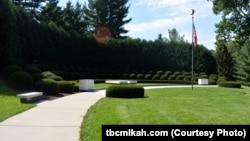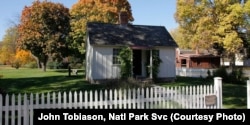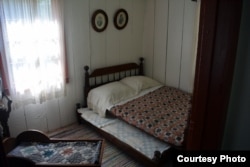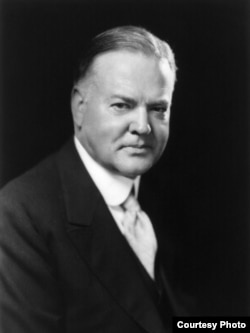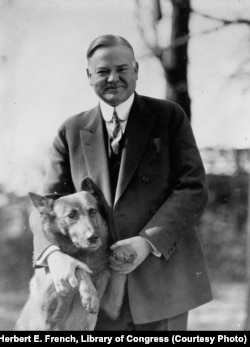In celebration of the National Park Service’s 100th anniversary this year, adventurer Mikah Meyer is traveling across America with the goal of visiting every one of the more than 400 sites within its jurisdiction.
The young traveler set out from Washington, D.C., in June and has already experienced dozens of sites. And VOA has been following him every step of the way.
Thanks to the stunning photographs and videos Mikah and his travel companion Andy Waldron have been sending us, we have a virtual front row seat to some of the most amazing land and seascapes within the park system. As one observer recently noted, it’s almost as good as being there.
But as Mikah discovered on his latest adventure, not all park service sites are natural wonders.
Simple beginnings
Mikah left the natural splendor of lush forests and wild rivers for a quick visit to the Herbert Hoover National Historic Site in rural West Branch, Iowa, the birthplace of America’s 31st president, who served from 1929 to 1933.
The main attraction in this small rustic town is the little two-room cottage that was President Hoover’s home for the first few years of his life. One room of the small but sturdy house served as a bedroom for the young Herbert, his parents and two siblings, the other as a combination living room, dining room and kitchen.
It took Mikah just a few minutes to view the whole house.
“Compared to all the other places I had recently visited that were so much bigger and had so much more to offer, I got there and I thought, ‘really, this is it? I drove all this way for this?’” he said to VOA in a recent conversation.
“For somebody like myself who grew up in a prairie state, it basically looked like my grandma's house,” he said, suggesting that it was not as fascinating for him as it might be for visitors unused to country life.
But then he thought about a comment president Obama had made in 2015 praising the diversity of the National Park Service and how the sites it oversees encompass so much more than just natural areas.
“He mentioned that many sites within the park service are being preserved for history …and this was a good example of that,” Mikah said. And it's an especially great site "for people who are interested in presidential history,” he added.
Near Hoover's boyhood home is an old school house, a blacksmith shop and a Quaker meeting house, as well as the gravesites of the president and his wife, Lou Henry Hoover.
A great humanitarian
What also helped make up for Mikah’s disappointment in the cottage was Hoover’s presidential library that was also on the site. While it isn’t part of the National Park Service, Mikah made a point to visit it. “It was nice to get more of the complete story about the president and learn how he’d done so much humanitarian aid,” he said.
Mikah learned that when World War I began in August 1914, Hoover -- a hugely successful mining engineer at the time -- helped organize the return of around 120,000 desperate Americans from Europe. Responding to a personal request from the U.S. Ambassador to Britain, Hoover led 500 volunteers in distributing food, clothing, steamship tickets and cash from the Savoy hotel in London.
"I did not realize it at the moment, but on August 3, 1914 my engineering career was over forever," he is quoted as saying at the time, "I was on the slippery road of public life."
Hoover's humanitarian relief efforts in England -- and other countries in Europe such as Belgium where he helped feed the entire country for the duration of the war -- got the attention of U.S. president Woodrow Wilson, and later presidents ... transforming the career of a successful private citizen into a lifetime of devoted public service.
Small town values
History buffs may indeed be interested to learn that Herbert Hoover often attributed his strong morals and work ethic to the values he learned as a child, which guided him throughout his life.
“This cottage where I was born is physical proof of the unbounded opportunity of American life,” he once wrote.
Hoover’s parents and grandparents arrived in West Branch in horse-drawn wagons, hoping to find a new life for their families.
His parents and other members of the close-knit Quaker community helped shape his values during his early childhood, with an emphasis on simplicity, integrity, equality, peace and service to others.
He relied on those values to overcome the tragedy of becoming an orphan at the age of nine and when he had to leave Iowa to live with relatives in Oregon a short time later.
They became a source of strength once again when he took office in 1929, as the nation was plunging into what became known as the Great Depression; a severe worldwide economic depression that took place during the 1930s.
And they are symbolized in the mission the planners of the park had, as reflected in a sign on the grounds which reads, "the commemorative landscape would reflect that in America, anyone, including an orphaned boy from a small town, can achieve great things."
Coming attractions
In the coming days Mikah will be visiting a few national parks in Chicago before heading to Indiana.
Follow Mikah
To follow Mikah and learn more about the places he’s traveling to, he invites you to visit him on his website.




